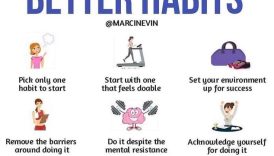Healthy Living Starts with Healthy Eating: A Nutrition Guide

Importance of Healthy Eating
Healthy eating isn’t just a trend; it’s a lifestyle choice that impacts overall well-being. The foods we consume play a crucial role in determining our physical health, mental clarity, and energy levels. When individuals prioritize nutritious meals, they often experience increased immunity and reduced risks for chronic diseases such as diabetes, heart disease, and obesity. For example, a friend of mine switched from a diet heavy in processed foods to one comprising whole foods. Over just a few months, she noticed not only weight loss but also improved mood and energy levels. She shared that she felt sharper at work and more active during her workouts. This transformation illustrates how healthy eating can significantly impact daily life. Incorporating a variety of nutrients helps maintain a balanced lifestyle. Here are a few reasons why healthy eating is paramount:
- Healthy Living Starts with Healthy Eating: A Nutrition Guide
- Importance of Healthy Eating
- What is a Nutrition Guide?
- Understanding Food Groups
- Importance of Balanced Diet
- Role of Macronutrients and Micronutrients
- Planning Meals for Nutritional Value
- Creating a Healthy Meal Plan
- Portion Control and Timing
- Choosing Nutrient-Rich Foods
- Importance of Whole Foods
- Incorporating Fruits and Vegetables
- Reading Nutrition Labels
- Understanding Serving Sizes
- Identifying Added Sugars and Unhealthy Fats
- Enhanced Longevity: A well-balanced diet can prolong life by reducing disease risks.
- Improved Physical Performance: Nutrient-dense foods fuel physical activities and help in recovery.
- Better Mental Health: Certain foods can boost mood and cognitive function.
What is a Nutrition Guide?
A nutrition guide serves as a roadmap for making healthier food choices. It provides valuable information on nutrient requirements, food groups, and portion sizes, making it easier for individuals to navigate the often overwhelming world of dietary options. Think of a nutrition guide as a personalized coach for your eating habits. In simpler terms, a nutrition guide can help individuals:
- Understand Food Groups: It categorizes foods into groups like grains, proteins, fruits, vegetables, and dairy.
- Track Nutrient Intake: By understanding the macro and micronutrients, one can make informed choices.
- Set Goals: Whether one aims to maintain weight, lose weight, or gain muscle, a nutrition guide tailors recommendations accordingly.
Overall, embracing a nutrition guide can transform everyday eating into a healthier experience, steering individuals toward long-term well-being.
Understanding Food Groups
Importance of Balanced Diet
When delving into the world of nutrition, understanding food groups is fundamental. A balanced diet is not just about counting calories; it’s about ensuring that the body receives all essential nutrients it requires to function optimally. Did you know that the body functions best when it receives a diverse mix of foods? My neighbor, who used to rely heavily on takeout meals, felt sluggish and drained. He decided to educate himself on food groups and began preparing balanced meals. In a few weeks, he reported feeling more energetic and even sleeping better. Here are the core reasons why a balanced diet is crucial:
- Supports Overall Health: Provides essential vitamins, minerals, and energy.
- Enhances Mood: Certain foods can boost serotonin levels, contributing to better mental health.
- Promotes Healthy Weight Management: Balanced nutrition helps regulate appetite and reduces cravings.
A balanced plate generally includes the following food categories: carbohydrates, proteins, fats, fruits, and vegetables.
Role of Macronutrients and Micronutrients
Understanding macronutrients and micronutrients helps one recognize what their body truly needs. Macronutrients are nutrients the body requires in larger amounts. They include:
- Carbohydrates: The primary energy source. Found in grains, fruits, and vegetables.
- Proteins: Essential for muscle repair and growth. Sources include meat, beans, and nuts.
- Fats: Necessary for hormone production and nutrient absorption. Healthy fats can be found in avocados, olive oil, and fish.
On the other hand, micronutrients are required in smaller quantities but are just as important:
- Vitamins: Such as Vitamin C for immune function and Vitamin A for vision.
- Minerals: Like calcium for bone health and iron for blood transport.
Both macronutrients and micronutrients work together to ensure that the body operates efficiently. This interplay exemplifies why focusing solely on calories can be misleading; nutrient quality is equally pivotal for health. In changing one’s eating approach to include a variety of food groups, one may uncover a better quality of life in both physical and mental aspects.
Planning Meals for Nutritional Value
Creating a Healthy Meal Plan
Once the basics of food groups and nutrients are understood, the next step involves planning meals for nutritional value. Creating a meal plan helps streamline grocery shopping and meal preparation—ensuring healthier choices become second nature. A method I’ve found particularly effective is the “Sunday Prep Day.” Each week, I sit down to outline my meals for the next seven days. This strategy keeps me accountable and my fridge stocked with nutrient-rich options. Here’s how to build a healthy meal plan:
- Set Goals: Decide what you want to achieve—weight loss, balanced nutrition, or muscle gain.
- Choose Variety: Select meals from each food group. This not only keeps meals exciting but also ensures you’re obtaining all necessary nutrients.
- Make a Grocery List: Based on your meal plan, compile a list of ingredients, avoiding impulse buys.
- Prep Ahead: Prepare ingredients in bulk—washing, chopping, and portioning—to make cooking quicker during the week.
For example, I often batch-cook quinoa and roast a variety of vegetables on Sundays. It saves time and creates a delicious base for salads or stir-fries throughout the week.
Portion Control and Timing
Now that meals are planned, understanding portion control and meal timing is essential. Many people struggle with portion sizes, leading to overeating. Here’s where a bit of mindfulness can help:
- Use Smaller Plates: Research suggests that smaller dishes can trick our brains into feeling satisfied with less food.
- Follow the Plate Method: Fill half your plate with fruits and vegetables, one quarter with protein, and one quarter with whole grains.
Additionally, meal timing can affect metabolism and overall energy levels.
- Regular Eating Schedule: Aim to eat at the same intervals each day to maintain steady energy levels. For instance, I typically enjoy a hearty breakfast, a light lunch, and a balanced dinner with healthy snacks in between.
Incorporating these principles into daily eating habits can enhance nutritional value while ensuring that meals are not only healthy but also enjoyable. By creating a structured meal plan, practicing portion control, and paying attention to timing, anyone can cultivate a healthier relationship with food.
Choosing Nutrient-Rich Foods
Importance of Whole Foods
Once meal planning is underway, the next step is to focus on choosing nutrient-rich foods. Prioritizing whole foods can make a significant difference in overall health and well-being. Whole foods are those that are minimally processed and remain close to their natural state, including fruits, vegetables, whole grains, nuts, and lean proteins. For instance, I recall a time when I switched from white rice to brown rice. The difference wasn’t just in flavor; I noticed increased energy levels and a satisfied feeling that lasted much longer. Whole foods are beneficial for several reasons:
- Higher Nutrient Density: Whole foods are often packed with vitamins, minerals, and antioxidants that help combat diseases.
- Better Fiber Content: Foods like whole grains and legumes provide fiber, which aids digestion and keeps you feeling full.
- Less Added Sugar and Preservatives: Whole foods typically lack the unnecessary additives found in processed products, making them healthier options.
Including plenty of whole foods in daily meals can lead to profound health improvements, and it’s an easy switch to make.
Incorporating Fruits and Vegetables
Fruits and vegetables are cornerstones of a nutrient-rich diet. They are colorful, flavorful, and brimming with essential nutrients. However, many individuals struggle to consume the recommended servings each day. To remedy this, I’ve adopted a simple rule: “Make half your plate fruits and vegetables.” Here are some tactics to seamlessly incorporate more produce into your diet:
- Smoothies: Blending fruits and leafy greens provides a delicious way to increase servings. My morning smoothie consists of spinach, banana, and berries—quick and nutritious!
- Snacking: Keep cut-up veggies and fruits near your workspace or in the fridge for easy access. Carrot sticks and hummus have become my go-to afternoon snack.
- Veggie-Forward Dishes: Experiment with adding vegetables to your favorite recipes. For example, adding spinach to omelets or zucchini to pasta dishes can boost nutrition effortlessly.
By cultivating the habit of choosing whole foods and regularly incorporating fruits and vegetables into meals, not only can individuals enhance their nutrient intake but also foster a more enjoyable and sustainable approach to eating. Embracing these choices builds the foundation for a healthy lifestyle—one delicious bite at a time.
Reading Nutrition Labels
Understanding Serving Sizes
As individuals embark on a journey to make healthier food choices, becoming proficient in reading nutrition labels is essential. Nutrition labels provide valuable information about what is truly in the food we eat, starting with serving sizes. It’s surprising to see how serving sizes can vary between products. For example, I once picked up a bottle of granola, only to find that the serving size was just a quarter cup. Initially, I was shocked; I thought I’d been eating a healthy portion when, in reality, I was consuming double or more! Understanding serving sizes is critical because it influences calorie intake and the nutritional value of a meal. Here are a few tips to help decode serving sizes:
- Check the Serving Size First: Always begin by looking at the serving size listed at the top of the label. This will guide you in assessing how many portions you consume.
- Compare Packages: If you’re comparing different brands, remember that serving sizes might not be consistent. It’s crucial to compare per serving rather than per package.
- Use Measuring Tools: Especially in the beginning, using measuring cups or a food scale helps to grasp visualizing actual portions until you feel more comfortable.
Identifying Added Sugars and Unhealthy Fats
After mastering serving sizes, the next critical aspect is recognizing added sugars and unhealthy fats on nutrition labels. These components can detrimentally affect health when consumed in excess.
- Spotting Added Sugars: Look for the term “added sugars” listed under carbohydrates. Common culprits include syrups, honey, and any ingredient ending in “-ose,” like glucose or fructose. For instance, I learned to double-check yogurt labels since many brands add sugars, turning a healthy snack into a sugary treat.
- Unhealthy Fats Awareness: Labels also specify the types of fats—saturated and trans fats are the ones to limit. Saturated fats are typically found in animal products, while trans fats are often present in processed foods. I once discovered that a brand of microwave popcorn I loved had a considerable amount of trans fats, leading me to seek out healthier alternatives.
By paying attention to serving sizes and identifying added sugars and unhealthy fats, readers can make more informed choices. This knowledge can transform shopping habits, leading to a healthier lifestyle and ultimately benefiting long-term wellness. Embracing these practices empowers individuals to take control of their dietary choices consciously.




